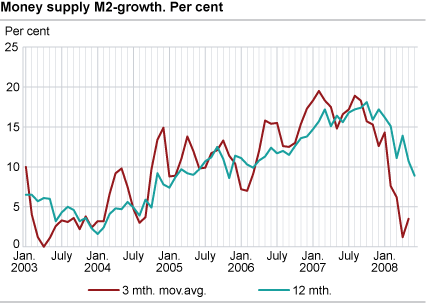Content
Published:
This is an archived release.
Lower growth in money supply
The twelve-month growth in total money supply was 8.9 per cent to end-June, down from 10.7 per cent to end- May. The growth in money supply is now at its lowest since November 2005.
The money supply amounted to NOK 1 466 billion at end-June, up from NOK 1 433 billion at end-May. The decline in the annual growth to end-June is a result of a higher growth in June last year than in June this year. All sectors saw a decline in their money supply growth in June.
Declining growth for household
At end-June more than half (NOK 785 billion) of the broad monetary aggregate was owned by households. The twelve-month growth in household money supply fell from 9.5 per cent to 8.7 per cent during June. Households have been the main contributor to annual growth in money supply for six consecutive months. The growth in household money supply was a little lower than the growth in household gross debt, which was 9.8 per cent to end-June, as shown by the credit indicator C2 . For more information on the financial position of households, see the financial accounts in the national accounts .
Slowdown also in non-financial enterprise money supply growth
Non-financial enterprise money supply amounted to NOK 491 billion at end-June. The twelve-month growth was 5.2 per cent, compared to a yearly growth of 7.2 per cent recorded in the previous month. The twelve-month growth rate has been decreasing since December 2006, when it reached 35.5 per cent. Apart from the past four months, we must back to April 2005 to find yearly growth rates below 10 per cent. Non-financial enterprise money supply constituted barely 44 per cent of their gross domestic debt measured by the credit indicator C2 at end-June, while this share was higher than 50 per cent during most of 2007.
| January 2008 | February 2008 | March 2008 | April 2008 | May 2008 | June 2008 | ||||||||||||||||||||||||||||||||||
|---|---|---|---|---|---|---|---|---|---|---|---|---|---|---|---|---|---|---|---|---|---|---|---|---|---|---|---|---|---|---|---|---|---|---|---|---|---|---|---|
| M0 - 12 mth. | -8.7 | -3.0 | -3.9 | 10.7 | 22.2 | 17.7 | |||||||||||||||||||||||||||||||||
| M1 - 12 mth. | 10.8 | 9.4 | 6.1 | 7.6 | 5.0 | 3.4 | |||||||||||||||||||||||||||||||||
| M2 - 12 mth. | 16.2 | 15.1 | 11.1 | 13.9 | 10.7 | 8.9 | |||||||||||||||||||||||||||||||||
| M2 - 3 mth. moving average | 14.3 | 7.6 | 6.2 | 1.2 | 3.5 | ||||||||||||||||||||||||||||||||||
| M2 households - 12 mth. | 10.7 | 10.6 | 9.3 | 10.2 | 9.5 | 8.7 | |||||||||||||||||||||||||||||||||
| M2 non-financial enterprises - 12 mth. | 15.6 | 13.5 | 7.8 | 11.2 | 7.2 | 5.2 | |||||||||||||||||||||||||||||||||
Composition of money supply
The broad monetary aggregate M2 amounted to NOK 1 466 billion at end-June, of which the major part (89 per cent) consisted of bank deposits. In comparison, notes and coins only accounted for 3 per cent of the broad money. The rest of the broad money consisted of shares in money market funds (7 per cent) and certificates of deposits (1 per cent).
|
The money supply (broad monetary aggregate) M2 consists of notes and coins, unrestricted bank deposits, certificates of deposit and units in money market funds owned by households, non-financial enterprises, municipalities and financial enterprises other than state lending institutions, banks and money market funds. |
The statistics is published with Monetary aggregates.
Contact
-
Statistics Norway's Information Centre
E-mail: informasjon@ssb.no
tel.: (+47) 21 09 46 42

